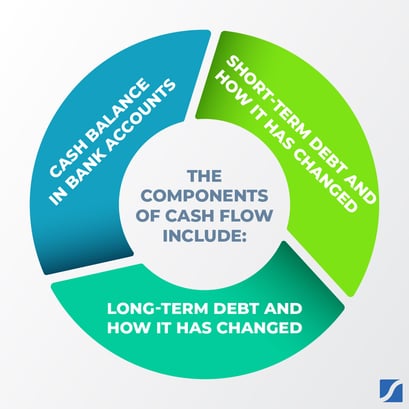Why Is Cash Flow Management Important To Survive In a Tough Business Climate?


Today's three most significant challenges facing the business world—inflation, talent retention, and supply chain issues—have left many companies looking for ways to ensure that their finances weather the storm.
You might be closely monitoring your company's revenue and profit if you’re an entrepreneur, CEO, or another executive. You might believe that keeping those measures in check will help you scale your business even during these difficult times.
But if you think focusing on your company’s revenue and profit will help it thrive financially, it’s time to change that thinking. It’s time that your entire management team learns the importance of your business’s cash flow story.
And that story revolves around this fact: Revenue is vanity. Profit is sanity. Cash is king or queen.

Having adequate cash flow shows your organization’s capacity to fund business growth and repay debt.
With many businesses facing tough decisions in a challenging business climate, it’s become critical that companies understand the value of cash too.
Your entire management team must access and understand your cash flow story. This story helps you align efforts to protect cash. It provides the information you can communicate internally and externally regarding your business’s finances.
This article will examine the importance of your cash flow story and the chapters that tell it. And in my next article, we’ll dig into decisions your management team can make to improve that story.
What Is Cash Flow?
Cash flow is the movement of money in all your business’s bank accounts during a given period or everything transferred in and out of your accounts. When you look at your bank accounts every week, month, and quarter, cash flow is the amount of money you’ve taken in compared with the last review. If you start a calendar year with $10,000 in an account and end the year with $1,000, then your cash flow for that period is -$9,000.
The components of cash flow include:
- Cash balance in bank accounts
- Long-term debt and how it has changed
- Short-term debt and how it has changed

The change in cash flow from one period to the next shows your company’s financial journey. It tells your economic story.
Why Is Your Company’s Financial Story Important?
Cash flow is the most accurate barometer of a company’s financial health—but many business owners have concerns about cash flow management. How can you stay on top of your organization’s cash flow?
It will help if you become a financial storyteller.
It’s essential to learn the 4-chapter story that your cash flow tells you about your business and the quality of its cash flow. And your management team must know the story to find improvements or fixes for any issues.
You can play the cash flow game when you know your company’s financial story. The object of your cash flow game is more cash, and you get that cash by evaluating progress and adjusting plans that inform your business growth.
When you win the cash flow game, you build your fortress balance sheet that protects your company from today’s volatile business climate.
What About Revenue and Profit?
Revenue and profit are essential, and the world typically focuses on these measurements when evaluating a company’s success. But those elements are simply inputs that affect your company’s cash flow.
Revenue and profit are part of Chapter 1 of your company’s financial story. But the whole economic story has four chapters.
So, if you’re looking at revenue and profit, you’re only a quarter of the way through the story. And you wouldn’t stop after 1 chapter of a murder mystery and then try to determine who committed the crime, would you?
What Is A Balance Sheet?
Companies in 96 countries around the world use the cash flow story approach. The lion’s share of those organizations began questioning their financial story by wondering: Why is there a gap between our profit and our cash flow?
Your balance sheet helps to put the answer in focus. It’s a snapshot of your company’s assets and liabilities at any given time.
It also provides Chapter 2 of your business’s 4-chapter financial story.
But management teams usually are terrified of balance sheets because they’re complex. You can help them overcome that fear by summarizing the balance sheet in a simple statement: Funding equals operations.
Put another way, debt and equity make up your company’s funding. That funding represents your operations or working capital. Your management team should direct its focus to the following figures on a balance sheet, which are the operations that are management’s responsibility to address:
- Accounts Receivable—How quickly your company receives payment
- Inventory (Work In Progress in a service company)—How much product or work in process you hold
- Accounts Payable—How quickly you pay suppliers’ invoices
The rest of the balance sheet is Chapter 3, or other capital.
What’s Your Cash Flow Management Story?
Your company’s management team is responsible for profit and working capital, but your chief executive answers for the result: Chapter 4, or net cash flow. Here are all the chapters in the cash flow management story—and how they work together:
- Chapter 1: Profit—The result of generating revenue over expenses
- Chapter 2: Working Capital—A measure of figures such as collections, receivables, inventory, and how you pay suppliers
- Chapter 3: Other Capital—Investments in additional infrastructure such as land and buildings
- Chapter 4: Net Cash Flow, or the funding of cash—The result of the first three chapters
Putting Your Financial Story Together
Once you understand how much cash your business has generated in a given period, it’s time to move to the next phase: making decisions that improve your cash flow story. Those decisions can be as easy as a few 1% or 1-day changes, which can have a dramatic effect.
If you’re ready to learn—and act on—your business’s cash flow story, I hope you’ll read my next article to learn tips for winning another game, which I call “Improvement.” In the meantime, here are some resources for learning more:
- Watch the replay of my webinar “Business Made Simple: The 1% Rule for Forecasting & Cash Flow.” You’ll get more tips for integrating your cash flow story into everyday decisions and see a case study that shows the value of intelligent cash flow management.
- Register for the Master Business Course “Managing Cash, Profit, & Value” with MBD All-Access membership. You’ll discover how taking control of your organization’s financial numbers can help you quickly scale your business.
- Access the Cash Flow Is King learning suite. You’ll find information about cash flow management and its importance to a company’s financial health.



